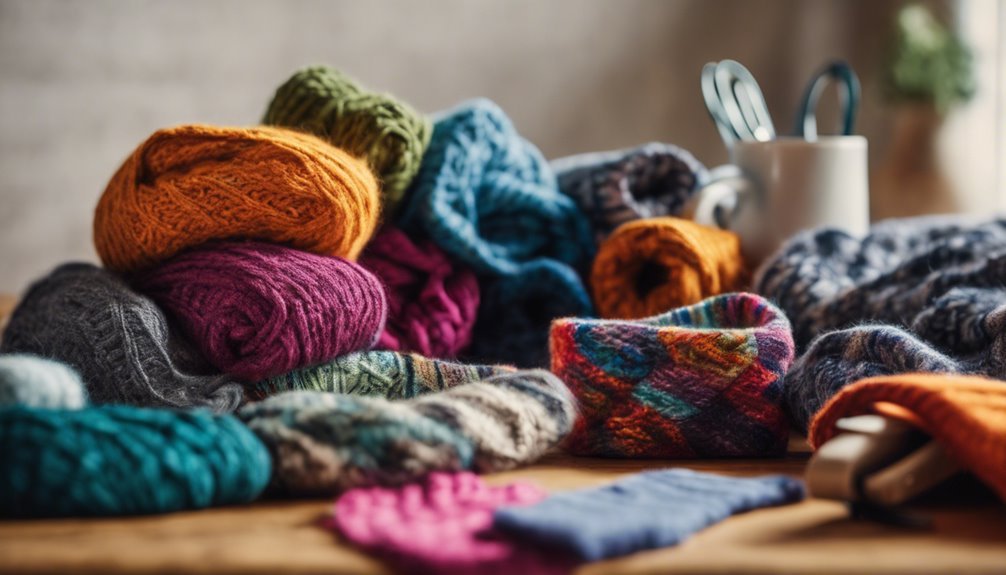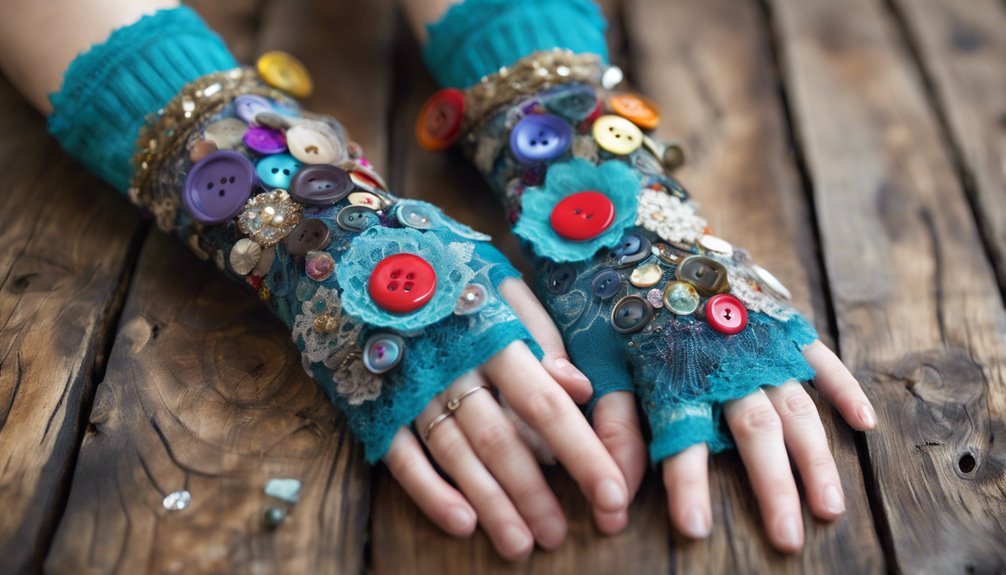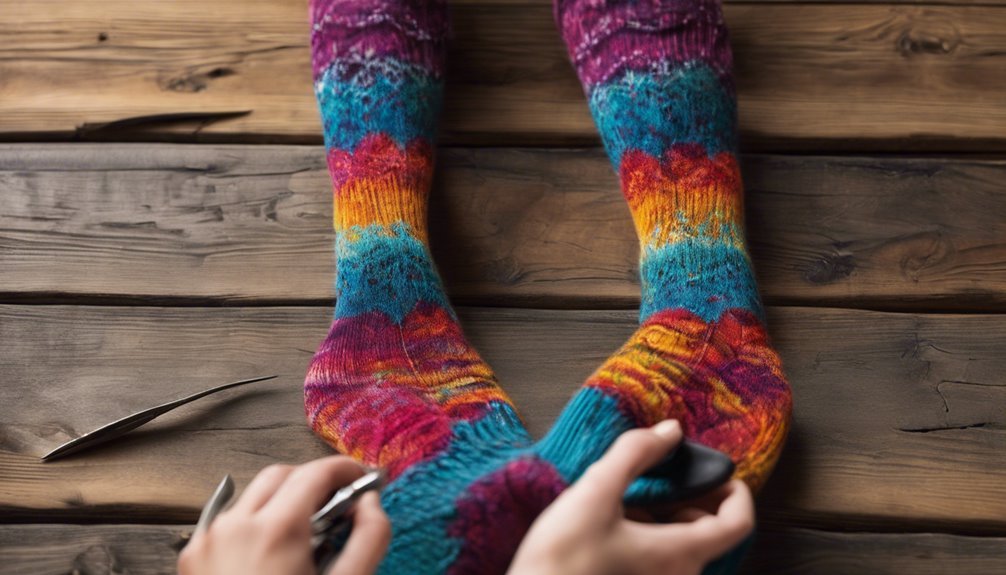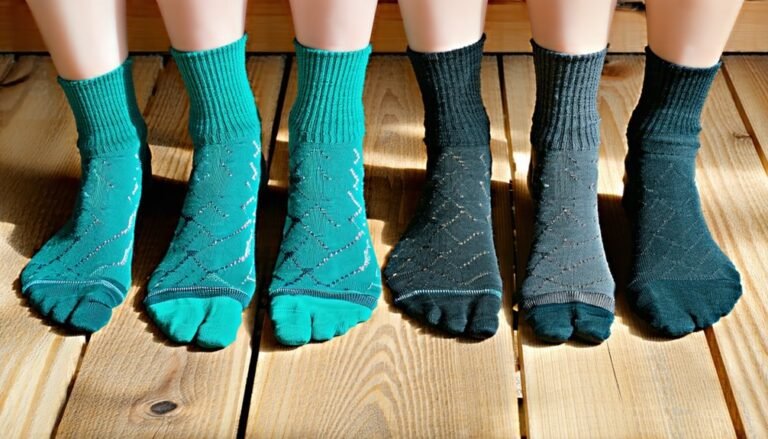Turn Your Socks Into Fingerless Gloves (No Sewing Required!)
Imagine this: it's a chilly morning, and you're searching through your drawer for something to keep your hands warm, but all you find are your favorite colorful socks.
What if you could turn those socks into stylish fingerless gloves without sewing? With a bit of creativity, you can transform those comfy socks into a fashionable accessory.
Simply grab socks with good elasticity, measure the length, and mark where you want to cut. Snip across the marked line and make a small incision near the heel for your thumb. Slip them on, and pay attention to any tight spots, adjusting for a snug fit.
For added flair, consider embellishing with buttons or fabric paint. Wash gently and air dry for longevity.
Stay tuned to explore creative styling and maintenance tips.
Gather Your Materials

Before you plunge into transforming your socks into fingerless gloves, it's essential to collect all the necessary materials to guarantee a smooth crafting process. First, gather your sock materials—ensure the socks are stretchy and comfortable, offering you the freedom to move. Explore your sock drawer and discover vibrant color combinations that reflect your personality. Think outside the box: mix bold hues or subtle pastels to express your unique style.
You'll also need a sharp pair of scissors for precise cuts. A ruler or measuring tape will help you maintain symmetry, while a fabric marker can guide your cuts with accuracy. Finally, grab some fabric glue to secure edges if needed. With these materials at hand, you're ready to release your creativity!
Choose the Right Socks
When choosing socks for your fingerless gloves project, consider the material and stretchability to guarantee they comfortably fit your hands. Opt for patterns and styles that express your personality, turning practicality into a fashion statement. Don't forget to assess the thickness and warmth, especially if you want your gloves to keep you cozy during chilly days.
Material and Stretchability
To transform socks into fingerless gloves effectively, start by considering the material and stretchability, as these factors determine comfort and fit. Opt for fabric types that blend cotton or wool with a touch of spandex or elastane. This combination offers warmth and breathability, while elasticity factors guarantee they snugly fit your hands without slipping.
For a creative solution, raid your sock drawer for those slightly stretched-out pairs. They'll provide more freedom for your fingers. If you're resourceful, consider using a mismatched pair to add a unique flair. When evaluating stretchability, give the socks a gentle tug. They should return to their original shape easily—this indicates good elasticity and a glove-like fit. Remember, your hands deserve both style and comfort!
Pattern and Style
Choosing the right socks for your fingerless glove project is essential to achieving the perfect pattern and style. Start by exploring socks with unique sock patterns, like stripes, polka dots, or funky geometric designs. These patterns will transform your gloves into a bold fashion statement. Don't shy away from vibrant colors that express your individuality and freedom. Consider fingerless glove styles that match your personality—whether you're going for a bohemian vibe or a sleek, modern look.
For a more tailored fit and aesthetic, opt for socks with a defined cuff and heel. These features can add structure and flair to your gloves. Mix and match different sock patterns for each hand to create an even more daring and eclectic look. Release your creativity and enjoy the freedom of self-expression!
Thickness and Warmth
While selecting socks for your fingerless gloves, consider the thickness and warmth they offer, which can greatly enhance their practicality and comfort. Opt for socks with insulating layers—think wool or thermal blends—to guarantee maximum heat retention. This is essential, especially during chilly weather. Thicker socks provide a cozy barrier against the cold, perfect for outdoor adventures.
If you're aiming for a lighter option, choose cotton or a synthetic blend for milder climates. The beauty lies in how you can mix and match different thicknesses to suit your needs. Feel the freedom to experiment with varying textures and weights. Always test the stretch and comfort of the sock before cutting; you want them snug but not constricting. Embrace the warmth!
Measure and Cut
Lay your sock flat and decide how long you want your glove to be, marking the desired length with a fabric pen or chalk. Carefully cut across the marked line, ensuring a straight edge for a neat finish. Next, make a small incision near the heel for the thumb opening, but be cautious not to cut too wide—just enough for a snug fit.
Determine Glove Length
How do you determine the perfect length for your fingerless gloves? First, you'll want to measure from your wrist to just below your fingers. This is your base length. For a snug fit, measure wrist circumference and adjust the length accordingly. If your style leans toward a more relaxed, bohemian vibe, extend the length to cover part of your forearm. Consider functionality as well—shorter gloves allow more freedom for your fingers, while longer ones provide extra warmth. Once you've decided on your preferred style, lay your socks flat and mark the desired length with chalk or a fabric pen. Then, take a bold step and cut across the marked line. Remember, your creativity defines your style, so let your instincts guide you!
Trim Thumb Opening
With your glove length determined, the next step is creating a comfortable thumb opening. Slip the sock onto your hand, fingers through, and mark where your thumb naturally rests. This spot is your guide for the thumb hole. Using sharp scissors, carefully snip a small cut. Remember, it's easier to make it bigger later than to fix a large hole.
Consider the sock designs when cutting; a patterned sock might look best with the thumb hole aligned with the pattern. If your sock's fabric is prone to fraying, a dab of clear nail polish around the edges can prevent unraveling. Feel free to try different thumb hole placements for varied looks. It's all about what feels right and expresses your unique style!
Create Thumb Holes

To create thumb holes for your fingerless gloves, start by carefully examining the sock to determine the best placement. Consider both thumb hole dimensions and finger flexibility, ensuring your glove stays snug but allows freedom of movement. You can use a marker to outline the spot where your thumb naturally rests when the sock is on your hand. Then, use sharp scissors to make a small, horizontal slit.
Here's a helpful guide:
| Thumb Size | Slit Length | Finger Flexibility |
|---|---|---|
| Small | 0.5 inch | High |
| Medium | 0.75 inch | Medium |
| Large | 1 inch | Low |
| X-Large | 1.25 inches | Very Low |
| Custom | Adjust as needed | Adjust as needed |
This table helps you tailor your thumb hole for ideal comfort and flexibility.
Customize the Fit
Once you've crafted the perfect thumb holes, it's time to focus on customizing the fit of your fingerless gloves for maximum comfort. Start by slipping them on and noting any areas that feel too snug or loose. Adjusting fit is key here—stretch or fold sections to match your personal preferences. If the wrist area feels too tight, gently tug to loosen the fabric. For a tighter fit, fold the edge inward for extra snugness. Don't hesitate to play around with the length; simply trim excess material for a shorter style or leave it longer for more coverage. Remember, your gloves should reflect your unique style and needs, so customize freely until they fit like a second skin.
Add Decorative Elements

Although your fingerless gloves are now perfectly fitted, adding decorative elements can elevate them to a whole new level of style. Immerse yourself in the world of embellishment techniques and let your creativity run wild. Consider mixing and matching color combinations to reflect your personality. Here's how you can transform your gloves into a statement piece:
- Buttons: Sew vintage buttons for a retro vibe.
- Ribbons: Weave colorful ribbons through the cuffs.
- Beads: Glue small beads along the edges for a touch of sparkle.
- Fabric Paint: Use stencils to apply unique designs.
- Patches: Attach quirky patches for a playful look.
Experiment with these ideas to craft gloves that are as unique as you are. Embrace your freedom and let your gloves speak your style.
Test for Comfort
Before you showcase your newly crafted fingerless gloves, ensuring they're comfortable is essential. Begin by performing a comfort testing ritual. Slide your hands into the gloves, feeling the fabric's embrace. Flex your fingers, making sure there's no tightness around the knuckles. For a fit assessment, notice any pinching or discomfort as you move. Wiggle your fingers freely without restriction. If the wrist area feels snug, consider gently stretching the fabric by hand to achieve a more relaxed fit.
Next, engage in everyday activities—typing, gripping, or sipping a coffee. This will reveal if the gloves maintain comfort throughout varied motions. Should any area feel too constricting, snip small sections to loosen the fit. Remember, the goal is a blend of freedom and coziness.
Style Your Gloves
With comfort assured, let's turn our attention to styling your fingerless gloves. Embrace the latest fashion trends and adapt them to your unique flair. Here's how you can transform your simple creation into a chic accessory that complements seasonal styles:
- Mix and match patterns: Pair polka dots with stripes for an edgy, eclectic look.
- Experiment with textures: Layer lace or mesh over your gloves for an added touch of sophistication.
- Add embellishments: Sew or glue on buttons, beads, or patches to make them pop.
- Play with colors: Use fabric paint or markers to create ombre effects or bold statements.
- Incorporate seasonal themes: Attach small fabric leaves or snowflakes to echo nature's changes.
Let your creativity run wild and define your own style!
Care and Maintenance
To guarantee your fingerless gloves stay in top condition, proper care and maintenance are essential. First, handle them gently with these cleaning tips: a gentle hand wash in lukewarm water with mild detergent preserves their elasticity and vibrancy. Avoid wringing them out, instead press between towels to remove excess water. Air dry them flat on a clean surface to retain shape.
For storage ideas, consider rolling them loosely and placing in a breathable fabric bag to maintain their form and freshness. If you're traveling, tuck them into a small pocket of your backpack for easy access. This way, you'll always have them ready for spontaneous adventures. Embrace these practices, and your gloves will stand the test of time, adding flair to your free-spirited journeys.
Frequently Asked Questions
Can I Use Socks With Holes Already in Them?
Absolutely, you can use holey socks for creative upcycling. Embrace the freedom of transforming them into something new. Trim around the holes, ensuring they're on top, for a unique, breathable design. Enjoy your resourceful, stylish creation!
What Type of Socks Work Best for This Project?
Why not choose socks with fun patterns and comfy materials like cotton or wool? They're perfect for your creative project. Make certain the socks are stretchy yet snug, offering freedom to move while adding a splash of personality.
How Durable Are Sock Fingerless Gloves Compared to Traditional Gloves?
You've got to contemplate the durability comparison. Sock gloves might not last as long as traditional ones. Longevity factors include sock material and usage frequency. Experiment with reinforced socks and stretch your creative solutions for resourceful, budget-friendly alternatives.
Are There Any Eco-Friendly Benefits to Repurposing Socks This Way?
Repurposing socks offers sustainability benefits by promoting waste reduction. Embrace your freedom: creatively transform old socks into useful accessories. It's a resourceful tip that contributes to eco-friendliness, reducing landfill contributions while uniquely expressing your style.
Can I Use This Method to Make Full-Length Arm Warmers?
With 80% of socks being cotton, you can easily craft full-length arm warmers. Explore various arm warmer designs by cutting sock material styles creatively. Embrace your freedom to experiment and transform old socks into chic, cozy accessories.







